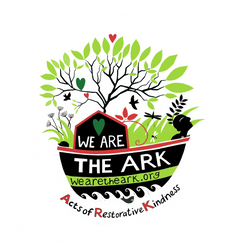Give at least half of your garden or land back to nature and if not half then as much as you can manage. Try to grow as much of your own organic food as possible in the other half. Protect and guide your Ark to re-wild through natures natural processes and it will become a more and more complex ecosystem over time. All land is welcome, even a window box full of local soil that allows the native weed seeds to flourish and provide food and reproductive partners for the insects is great! Ensure you have the neccessary permissions to convert the land you have in mind and your plans comply with all building standards and regulations. As well as nature you also need to put safety first so get familiar with all relevant guidelines to ensure everyone and everything involved in your Ark build can safely adhere to them.
Look through the links and resources available to help you make this decision and take the action that will affect positive change.
Put up a sign saying “THIS IS AN ARK"
This simple action removes the shame that people feel about having a wild, or as some might think, messy garden, and replaces it with pride that you’re doing something important to help all the creatures we are supposed to share the planet with. The We are the ARK website is set up to explain to interested neighbours what is happening on your Ark and why it is necessary. Here is a simple text PDF you can print out to get started.
There's a lot to do/undo as you return your garden/land to it's primary purpose so make a list and take your time to make deliverate and informed choices.
1. Have written permission from the landowner and copies of all building regulations and health and safety plans available.
2. Remove any non-native ‘Invasive plants’. This is difficult on a large scale but on our individual patches of earth, we can manage it easily enough by hand and through borrowed grazers or heavy sheet mulching. These plants do not move at 100MPH. There is NO place for chemicals in an ark, they cause many more problems than they solve and are very destructive to life on all levels.
3. Step in and provide any ecosystem services that we may need to provide due to the absence of the full circle of life. The aim is to create as many different habitats as possible in the land you have, habitats that would normally be created by keystone species which are missing from our island Arks. This develops as diverse an ecosystem as possible on your patch. If you have the space, consider creating multiple habitats such as an Ark meadow, a bare earth bank, piles of deadwood, a wildlife pond, a scrubby thorny thicket, a mature native woodland, a dry-stone wall etc.
4. Native plants are the foundation stone to any ecosystem. Arks are based on the native plants in your part of the world, wherever you may be. After careful observation of your Ark, if your soil is damaged or devoid of growth, the weed seed bank may be absent. In that case, sow an Ark meadow or a wildflower meadow to reboot the system and slowly introduce as many native plants as possible. Only use locally sourced native organic seeds, cuttings and plants (if possible) as these are vital genetic material for the local insect populations and have not been grown with poisons. Building your Ark involves careful mimicking of nature’s natural processes.
5. Make holes in your boundaries to allow wildlife to pass through. Learn to share your patches of this earth.
6. ARK Lighting. The blue and white toned lighting which is now in standard use, is one of the major factors in biodiversity collapse. Please aim for darkness or make sure all your ARK lights are red in tone (this lighting doesn’t affect them nearly as much). Make sure the outdoor lights are motion sensor only so that they only come on for short times when you need them and allow darkness to prevail in between.
Get together with like-minded folk
Get together with like-minded folk and approach your councils and home owners associations, your schools and university campuses and ask for support to turn more and more park and public spaces into Arks.
Add your Ark to our map
Please add your Ark on our map of Arks so that we can connect the dots and join our wildlife corridors to illustrate our vision for this movement.









 "All the greatest changes in the world have come from groups of people working together from the ground up. Below is a step by step guide based on my years of experience as a nature first garden designer and landscaper that will help you to create your own sanctuary for nature, in whatever space you have. Some of it will be counter intuitive but trust me, in time and with practice building an ARK will feel like the most natural thing in the world. Your land will re-establish itself as a simple ecosystem very quickly, and over time it becomes a strong wildlife habitat and eventually a multi-tiered complex community of native plants, creatures and micro-organisms."
- Mary Reynolds, Founder We Are The Ark
"All the greatest changes in the world have come from groups of people working together from the ground up. Below is a step by step guide based on my years of experience as a nature first garden designer and landscaper that will help you to create your own sanctuary for nature, in whatever space you have. Some of it will be counter intuitive but trust me, in time and with practice building an ARK will feel like the most natural thing in the world. Your land will re-establish itself as a simple ecosystem very quickly, and over time it becomes a strong wildlife habitat and eventually a multi-tiered complex community of native plants, creatures and micro-organisms."
- Mary Reynolds, Founder We Are The Ark
